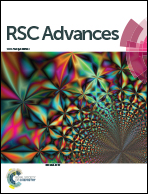Novel synthesis of silver/reduced graphene oxide nanocomposite and its high catalytic activity towards hydrogenation of 4-nitrophenol†
Abstract
A novel synthesis method was reported for the preparation of silver/reduced graphene oxide (Ag/RGO) nanocomposites via reducing AgNO3 in a macroscopic RGO aerogel directly through a convenient impregnation process. The as-prepared RGO-supported Ag nanocrystal exhibited high activity in the catalytic hydrogenation of 4-nitrophenol.


 Please wait while we load your content...
Please wait while we load your content...